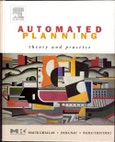Automated planning technology now plays a significant role in a variety of demanding applications, ranging from controlling space vehicles and robots to playing the game of bridge. These real-world applications create new opportunities for synergy between theory and practice: observing what works well in practice leads to better theories of planning, and better theories lead to better performance of practical applications.
Automated Planning mirrors this dialogue by offering a comprehensive, up-to-date resource on both the theory and practice of automated planning. The book goes well beyond classical planning, to include temporal planning, resource scheduling, planning under uncertainty, and modern techniques for plan generation, such as task decomposition, propositional satisfiability, constraint satisfaction, and model checking.
The authors combine over 30 years experience in planning research and development to offer an invaluable text to researchers, professionals, and graduate students.
Please Note: This is an On Demand product, delivery may take up to 11 working days after payment has been received.
Table of Contents
1 Introduction and Overview
I Classical Planning 2 Representations for Classical Planning3 Complexity of Classical Planning4 State-Space Planning5 Plan-Space Planning II Neoclassical Planning 6 Planning-Graph Techniques7 Propositional Satisfiability Techniques8 Constraint Satisfaction Techniques
III Heuristics and Control Strategies 9 Heuristics in Planning10 Control Rules in Planning11 Hierarchical Task Network Planning12 Control Strategies in Deductive Planning IV Planning with Time and Resources 13 Time for Planning14 Temporal Planning15 Planning and Resource Scheduling
V Planning under Uncertainty 16 Planning based on Markov Decision Processes17 Planning based on Model Checking18 Uncertainty with Neo-Classical Techniques
VI Case Studies and Applications 19 Space Applications20 Planning in Robotics21 Planning for Manufacturability Analysis22 Emergency Evacuation Planning 23 Planning in the Game of Bridge
VII Conclusion 24 Conclusion and Other Topics
VIII Appendices A Search Procedures and Computational ComplexityB First Order LogicC Model Checking








